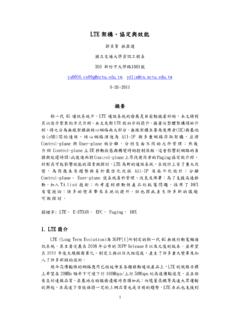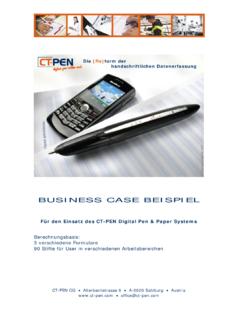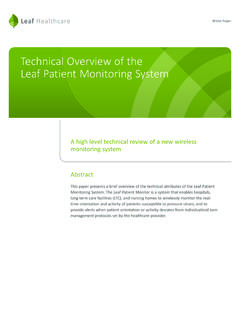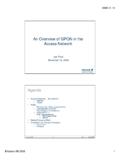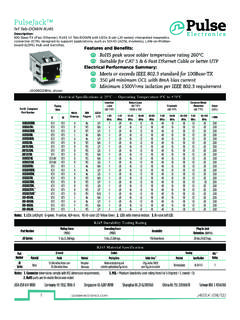Transcription of Contents
1 1 Victor WangAcuteSystem Testing 1 Testing of Ethernet SwitchAcute Communications Yao-Tzung WangAcuteSystem Testing 2 Why Test and Network Subsystems Network Test Environment Alternatives Philosophy and Methodology of Testing Test Classification Functional, Negative and Stress tests Testing Network Subsystems An Example: Ethernet Switches: ASIC/System Useful Information SummaryContents2 Victor WangAcuteSystem Testing 3 Keeping the network up and running Making the network better The cost-effectiveness of testing Third-party testingWhy Testing Networks ?Victor WangAcuteSystem Testing 4 File server (S1) Workstation (S2) Networking operating system: NOS (S3) Application, client-server database andworkstation desktop software (S4) Hubs, switches, bridges and routers (S5) Network segment (S6) Internetwork (S7)Seven Network Subsystems3 Victor WangAcuteSystem Testing 5 Recommended Test ObjectivesVictor WangAcuteSystem Testing 6 Real-world loadEmulated networkEmulated loadEmulated networkReal-world loadReal-world networkEmulated loadReal-world networkNetworkLoadTest Network ConfigurationTest EnvironmentDimensions4 Victor WangAcuteSystem Testing 7 Real-worldEmulationEmulationReal-worldTe st NetworkConfigurationNetwork LoadHighest cost - More time - More accurateLowest cost - Less time - Less accurateEmulation vs.
2 Real-WorldVictor WangAcuteSystem Testing 8 What type of loads ? A Windows client-server application A DOS word processing application A packet generator How much load ? Number of users Network load (%) Mixed-case loading Accelerated loading Used for reliability testingTraffic Load Modeling5 Victor WangAcuteSystem Testing 9 Response time Featute/Functionality Throughput Acceptance Configuration sizing Reliability Bottleneck identification and problem isolationTest PhilosophyVictor WangAcuteSystem Testing 10 An orderly system of procedures to ensure thatthe test results meet the test objective. The test results should be Accurate Reproducible RelevantTest Methodology6 Victor WangAcuteSystem Testing 11 Planning Load modeling Test configuration Data collection Data interpretation (Relevant results) Data presentation (Actionable results)Test Methodology ComponentsVictor WangAcuteSystem Testing 12 Functional Tests Verify that the DUT does what the specification says itshould or must do Negative Tests Verify that the DUT behaves appropriately if anotherdevice on the network is not functioning according tospecifications Stress Tests Verify that the DUT can perform correctly on busynetworks with many devices and a high volume ofnetwork trafficTest Classification7 Victor WangAcuteSystem Testing 13 Test SetupsVictor WangAcuteSystem Testing 14 DUT Multilayer (IP) SwitchUITESTERM ulti-Interface Testing8 Victor WangAcuteSystem Testing 15 DUT ATESTERBCABC111An Emulated Network (1)
3 Victor WangAcuteSystem Testing 16 ABCD111101 XDUT ATESTERBCDXAn Emulated Network (2)9 Victor WangAcuteSystem Testing 17 Routing SwitchHI-PriStreamLO-PriStreamStreamsSin k75%line rateOverload (150%) - 10 seconds75%line rateAnalyze the loss rate of two streamsPrioritizationVictor WangAcuteSystem Testing 18 Product Overview Test Equipment and Test Platform Basic Function Test (10/100/1000 Mbps) More than 30 test items Protocol Conformance Test GVRP/GARP GMRP Spanning Tree Protocol IGMP2 RIP2 OSPF2 DVMRP3 MOSPF Self-DevelopedSystem Test Plan (1)10 Victor WangAcuteSystem Testing 19 Performance/Reliability Test Refer to IETF RFC-2330: Framework for IP Performance Metrics About 15 test items SMB-AST (Advanced Switch Test): Max throughput, HOL blocking, X-stream Ixia Communications: Mesh peak load test Self-developed: BX-stream, EBX-stream, MCAST X-stream, mixed class X-stream Multivendor Interoperability Test Use different vendors router equipment to build real-world (treeor star Topology) operation Cisco, Bay Accelar, Xylan, Ascend, etc.
4 MIB Verification TestSystem Test Plan (2)Victor WangAcuteSystem Testing 20 IP Multicast Test Refer to IETF Draft: draft-thaler-multicast-interop-03 Refer to IETF RFC-2432: Terminology for IPMulticast BenchmarkingSystem Test Plan (3)11 Victor WangAcuteSystem Testing 21IP Multicast Test (1) Multicast Speedup Index (MSI) The ratio of unicast latency (d) to multicast latency (D), , (d/D). In the best case, D = d -> MSI = 1 In the worst case, D = n*d -> MSI = 1/n, where n depends on the destinationmulticast ports Multicast Latency (ML) The set of individual latencies from a single input port on the DUT to all testedports (more than two ports) belonging to the destination multicast group Group Join Delay (GJD) Time duration when an IGMP report has been issued to a DUT until the DUTstarts forwarding multicast packets Group Leave Delay (GLD) Time duration when an IGMP Leave Group message has been offered to aDUT until the DUT ceases forwarding multicast packetsVictor WangAcuteSystem Testing 22 X-Stream MCAST X-Stream (k) /* input line load = 1/k and k=2 (typical value) */12342 3 4 2 3 4.
5 3 4 1 3 4 1 ..4 1 2 4 1 2 ..1 2 3 1 2 3 ..1234b c d b c d ..c d a c d a ..d a b d a b ..a b c a b c ..Multicast groups for k=2 a={1, 2} b={2, 3} c={3, 4} d={4, 1}IP Multicast Test (2)12 Victor WangAcuteSystem Testing 23 Mixed Class X-Stream (k + 1) /* input line load = 1/(k + 1) */12342 b 3 c 4 d 2 b 3 c 4 d ..3 c 4 d 1 a 3 c 4 d 1 a ..4 d 1 a 2 b 4 d 1 a 2 b ..1 a 2 b 3 c 1 a 2 b 3 c ..IP Multicast Test (3)Victor WangAcuteSystem Testing 24 Protocol Conformance/Interoperability Lab Performance Evaluation Testing Tools SmartBits: ANVL: Standards RFCs: : : Information13 Victor WangAcuteSystem Testing 25 The value of testing = risk versus cost Risk includes productivity loss support cost lost sales Cost includes facility cost personnel costSummary
